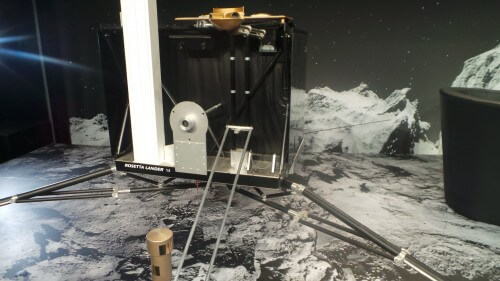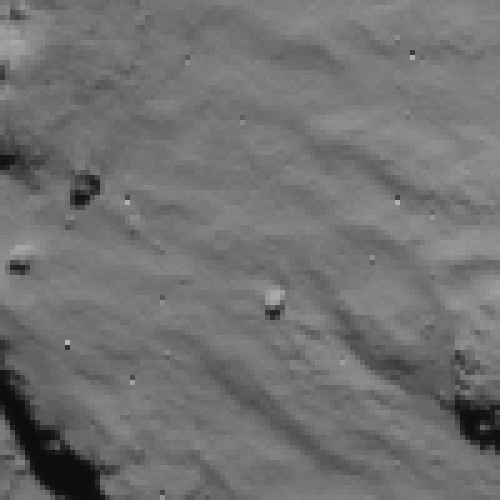The last broadcast from it was received on the night between Friday and Saturday and since then there has been silence. However, it managed to transmit the data from all the scientific instruments, and was tilted to take in a little more sunlight. This is probably not enough and it is possible that the situation will improve with the approach to the sun

Rosetta's Philae lander completed its primary mission 57 hours after landing on comet 67P Churimov-Grasimenko.
After going out of eye contact with the Philae lander since 09:58 GMT on Friday, Rosetta resumed contact with Philae that evening (22:19 PM). The signal was initially intermittent, but fortunately it stabilized and remained good until 00:36 on Saturday.
During these hours, the lander transmitted its technical status data as well as the scientific data from the dedicated instruments including, ROLIX, COSAC, Patholomei, SD2 and CONSERT. In doing so, she completed the measurements planned for the last part of the experiments on the surface.
In addition, the body of the lander was raised about 4 centimeters and shifted by 35 degrees in order to expose the solar collectors to additional hours of light, but after the last scientific data package was transmitted to Earth, the signal began to diminish.
"It was a huge success, the whole team is happy," said Steven Olmeck, the landing manager for the German Space Agency, who monitored Philae's progress from the European Space Agency's control center in Darmstadt, Germany this week.
"Despite an unplanned series of three landings, all our instruments were able to operate and now is the time to see what we got."

Against all odds - without an engine to brake the landing (all the gas used as fuel for this engine was not opened, therefore the European launch agency did not take a risk and did not even activate the engine, as the mission personnel informed the journalists, including your faithful servant, while ascertaining the landing situation AB) she arrived to its final resting place in the shadow of a cliff on November 12 at 17:32 GMT (comet time, it took the signal over 28 minutes to reach Earth via Rosetta).
The search for Philae's final resting place is still ongoing, through careful examination of the high-resolution photographs taken by instruments aboard Rosetta. Meanwhile, the lander returned unprecedented images of its surroundings.
As it plummeted toward the comet, the photographs showed that the comet's surface was covered in dust and debris ranging from millimeters to meters in size, panoramic images showed walls filled with layers of material that appeared to be harder. The teams of scientists are now studying the data to see which of these materials were successfully sampled with the Philae excavation.
"We still hope that at a later stage in the mission, perhaps when we are closer to the Sun, we will be able to receive enough sunlight to wake up the lander and resume communications," Olmak added.
From now on communication will not be possible unless enough light reaches the solar collectors to generate enough energy for the city. The possibility of this happening later in the mission increased when mission controllers issued commands to rotate the main body of the lander to which the solar collectors are attached. This may expose a larger area of the receptors to sunlight.
Rosetta will continue to listen for signals from Philae whenever its orbit brings it into line of sight with the lander. However, given the low charging capacity of the solar collectors at this time, it is unlikely that it will be possible to renew the connection with the lander in the near future.
Meanwhile, Rosetta went into orbit at an altitude of 30 kilometers above the comet. It will return to a 20 km orbit on December 6 and continue its mission to study the comet in detail as it increases its activity, en route to its closest point to the Sun on August 13, 2015.
Over the next few months, Rosetta will ascend to safer orbits as the comet's immediate environment fills with dust and gas ejected from it. However, from time to time it will dare to make approach flights - some at a distance of 8 kilometers from the center of the comet.
The data that will be collected by the lander will allow scientists to examine the short-term and long-term changes that will occur on the comet, and will thus allow answering some of the big and important questions regarding the history of the solar system - how was it formed and developed? How do comets work? What role did the comets play in the development of the planets, bringing water to the earth and maybe even life on other worlds.
"The data collected by Philae will make the mission a game-changer in comet science," says Matt Taylor, the chief scientist of the Rosetta project at the European Space Agency.
Fred Jansen, Rosetta project manager on behalf of the European Space Agency says: "At the end of an amazing but roller-coaster week, we are looking at the first successful soft landing on the comet. This is a historic moment for the European Space Agency and its partners. We now look forward to many months of interesting science from Rosetta and we may even be able to bring Philae back from hibernation at some point in time.”
Rosetta is a mission of the European Space Agency with a contribution from the member states and NASA. The Philae lander was provided by a consortium led by the German space agency DLR, the French space agency CNES and the Italian space agency ASI.
Landing on the comet - special coverage from Darmstadt on the Hidan site

14 תגובות
These days I remembered one of the books by the pioneer of science fiction Jules Verne, in which he describes launching a research expedition to land on a comet. You can see how far he went in his vision.
someone
I read that the resolution of the camera is one megapixel and that the photo is taken from a distance of 15 km. Each pixel in the image is 1.60 meters. Think that the spacecraft was launched 10 years ago, and that they don't put together the "last word" in this type of systems. The devices have to be very reliable and therefore go through a long period of testing before installation. In other words, this is a technology that is over 10 years old.
Someone - the low resolution, the lack of colors (besides black and white), are a result, in my opinion, of the shipping costs. A high-quality image captures a lot, so the connection between Rosetta and the Wonder should be continuous over time, and the connection between Rosetta and the Earth should also be continuous and over time.
Could it be that Rosetta has high quality images? And just wait for her to transmit all the more important information to Earth first?
Father, from the center of the comet or from the surface? (It seems to me that the distance from the surface is a little more relevant).
You're right, of course miles. will be fixed
"From time to time it will dare to make approach flights - some at a distance of 8 meters from the center of the comet"
Sounds like a mistake to me... maybe 8 kilometers? From the surface?
Why are the pictures so blurry? Do you invest tens of millions of dollars in a project and it is difficult to put a normal camera that knows how to focus?
Eli
Again you didn't understand what happened?
Awkward moment